Site of the Week 2/18/2022: From Norfolk Back to the Peninsula
Text and photos by SCOTT FYBUSH
Last week, we showed you one of the transmitter sites on the “Peninsula” side of Virginia’s Hampton Roads market. After heading east in last week’s installment over to Norfolk and Portsmouth, we head back across the water (this time on the I-64 Hampton Roads Bridge-Tunnel) to check out a few more sites in Hampton and Newport News.


We should have driven by this first site the previous day, when we were over on the east side of Hampton to see the WNIS (790) site, but we didn’t do all our research and historical info-gathering fast enough, so we didn’t realize how important the site at 1930 E. Pembroke Avenue.
This site has had broadcast activity since 1948, when WVEC radio built its studio and transmitter here. Initially a daytimer on 1050, WVEC was able to go full-time on 1490 after WSAP in Portsmouth moved from 1490 to 1350 (you’ll recall we saw that site last week). It soon expanded into TV, adding WVEC-TV on channel 15 from this site in 1953. As a UHF station in a VHF-dominated market, WVEC-TV struggled, but became one of the very rare Us to get to move to VHF. In 1959, WVEC-TV shifted to channel 13, moving its transmitter across the water to a site in Norfolk (which would eventually become WVEC’s main studio.)

After WVEC-TV left the UHF band, the studios stayed here on Pembroke Avenue for a few more years, even as transmitters moved around them. In 1962, WVEC added WVEC-FM on 101.3, but not from this site. Instead, it built a new transmitter site a few miles to the east – but a new FM station arrived here a few years later. WTID-FM on 104.5 was the sister station to WTID on 1270 (more on them in a moment), and it evolved over the years into today’s WNVZ, top-40 “Z104.5,” still broadcasting from the tower out back behind a building that’s been massively modified and expanded over the decades. Somewhere in here on the left side of the building is the core of what was once an Art Deco-looking WVEC building, and we’d love to know if anything remains inside from those years.


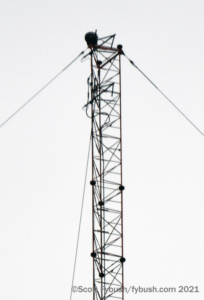
So about 1490: when WVEC moved its transmitter west in 1962, it was to a site that now sits right next to the busy ramp from I-664 to I-64 east, tucked in behind a subdivision that’s a few decades newer than the tower. WVEC radio changed calls over the years, becoming WWDE on both AM and FM; the WWDE calls survive to this day as “2WD” on FM, now broadcasting from a site over in Norfolk.
On the AM side, 1490 went through several iterations of format and owner, spending some time as part of the Redskins-owned Red Zebra sports network out of Washington. Today, WXTG carries a classic R&B format as “The Groove,” augmented by a translator on 101.9 mounted at the top of this tower. (There’s another leased tower site right next to 1490/101.9, but nothing broadcast there.)

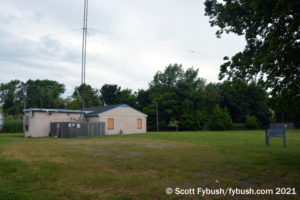
Got your scorecards ready? We mentioned up above that what’s now WNVZ 104.5 started as the sister to WTID on 1270, and we’re about to jump into that AM station’s complex history and its entanglement with a much older competitor.
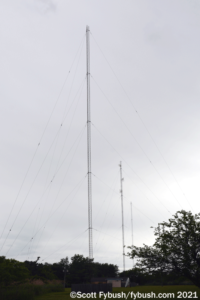
WHYU started out across the James River in 1947, as a daytimer licensed to Newport News but with a transmitter site near the mouth of Streeter Creek. In 1955, it moved its transmitter site to the southern tip of Newport News, at the foot of Jefferson Avenue, taking over a site that had already been in broadcast use for more than two decades. The Jefferson Avenue tower site had belonged to Newport News’ pioneer station, WGH (1310), but as we’ll see in a moment, WGH was on the move. (So was WHYU: it had moved into TV by signing on WACH-TV 33 as a sister station in 1953. The 1270 signal also became WACH, flipping to WYOU after the TV station failed in 1955. Among the radio employees here was a pre-“Wolfman” Bob Smith!)
After WYOU, 1270 became WTID, and in 1967 it left the Jefferson Avenue site to go full-time as a directional AM signal from a site near LaSalle Avenue and present-day I-64; today, these three towers are tucked in next to an apartment complex and a power substation that can’t be doing this signal any favors. (It was WTJZ for quite a few years and, after a call swap, is now WPMH, simulcasting a Black gospel format with what’s now WTJZ 1650 in Portsmouth and two FM translators.)
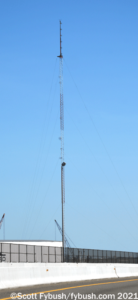

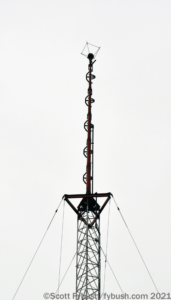
So about that Jefferson Avenue site and WGH: it still exists, and is still used by a station called WGH – but it took a while for things to circle around. WGH started out in Norfolk as WPAB in 1927, tried to relocate to Charlottesville and then Salisbury, Maryland, and finally ended up moving its license to Newport News in 1928, operating briefly as WNEW and then taking the “World’s Greatest Harbor” calls. A 250-watt station on 1310, WGH moved to a self-supporting tower here at the Jefferson Avenue location in the mid-1930s, building what was then a pretty splendid little Art Deco transmitter building that survives now with the windows bricked up and the red brick painted over.


WGH-FM signed on from here in 1947, initially on 96.5 before moving to its present 97.3. But then something happened in the early 1950s: WGH started building a new combined studio/transmitter site in what was then a sparsely-populated part of Hampton, a few miles to the east.
The AM side of WGH had moved around a bit: it went from 1310 to 1340 in the NARBA shuffle, but soon applied to go back to 1310 with more power. (The move off 1340 was what allowed WSAP over in Portsmouth to go from 1490 to 1350, opening up 1490 for WVEC – see, we told you this was all connected!)
On 1310, WGH went to 5 kW directional day and night once it moved to its new home on Military Road (today’s Mercury Boulevard) in 1949, and WGH-FM came along for the ride a couple of years later, moving to the top of one of the AM towers. The studio on Mercury kept growing (there are some fantastic pictures from its 1950s and 1960s heyday on the WGH History site), and the transmitter sites kept moving. After WTID built its new facility and left the Jefferson Avenue tower, WGH moved WGH-FM and the daytime signal for WGH(AM) back to the point in the 1960s. In 1967, it built the present 423-foot guyed tower here, as part of a bigger set of moves.

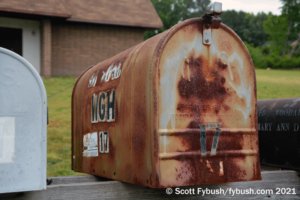
With Mercury Boulevard becoming a busy commercial strip, WGH apparently looked at moving all of its operations elsewhere.

In 1968, it moved the three-tower AM nighttime signal to a new site a few miles to the northeast, in an area off Newport News’ Main Street that was soon surrounded by suburbia. FCC records show that WGH initially planned to move its studios to this site as well, but instead stayed put for a while on Mercury.
Over the years, the WGH stations changed owners, eventually ending up with today’s Max Media. (We saw their studios on our last trip.) Both the AM and FM changed calls along the way – look carefully at the mailbox by the AM site and you can see a faded “97 STAR,” from its time as WRSR – but thankfully never both at once, allowing the three-letter calls to survive.
In recent years, WGH-FM has done country, broadcasting with a superpower 74 kW signal as “the Eagle” from the old site out on the point. The AM revived WGH’s oldies hits for a while, but is now doing “Money Talk” with a translator on 100.9 and an HD2 on WGH-FM. It ceased to be a two-site operation a few years back, and now operates both day and night from the former night-only site.
And with that, we’re on our way up I-64 in some gloomy rain, headed out of Hampton Roads with a promise to be back for even more sites and history!
SPRING IS HERE…
And if you don’t have your Tower Site Calendar, now’s the time!
If you’ve been waiting for the price to come down, it’s now 30 percent off!
This year’s cover is a beauty — the 100,000-watt transmitter of the Voice Of America in Marathon, right in the heart of the Florida Keys. Both the towers and the landscape are gorgeous.
And did you see? Tower Site of the Week is back, featuring this VOA site as it faces an uncertain future.
Other months feature some of our favorite images from years past, including some Canadian stations and several stations celebrating their centennials (buy the calendar to find out which ones!).
We still have a few of our own calendars left – as well as a handful of Radio Historian Calendars – and we are still shipping regularly.
The proceeds from the calendar help sustain the reporting that we do on the broadcast industry here at Fybush Media, so your purchases matter a lot to us here – and if that matters to you, now’s the time to show that support with an order of the Tower Site Calendar. (And we have the Broadcast Historian’s Calendar for 2025, too. Why not order both?)
Visit the Fybush Media Store and place your order now for the new calendar, get a great discount on previous calendars, and check out our selection of books and videos, too!
And don’t miss a big batch of Hampton Roads IDs next Wednesday, over at our sister site, TopHour.com!
Next week: Charlottesville, Virginia


